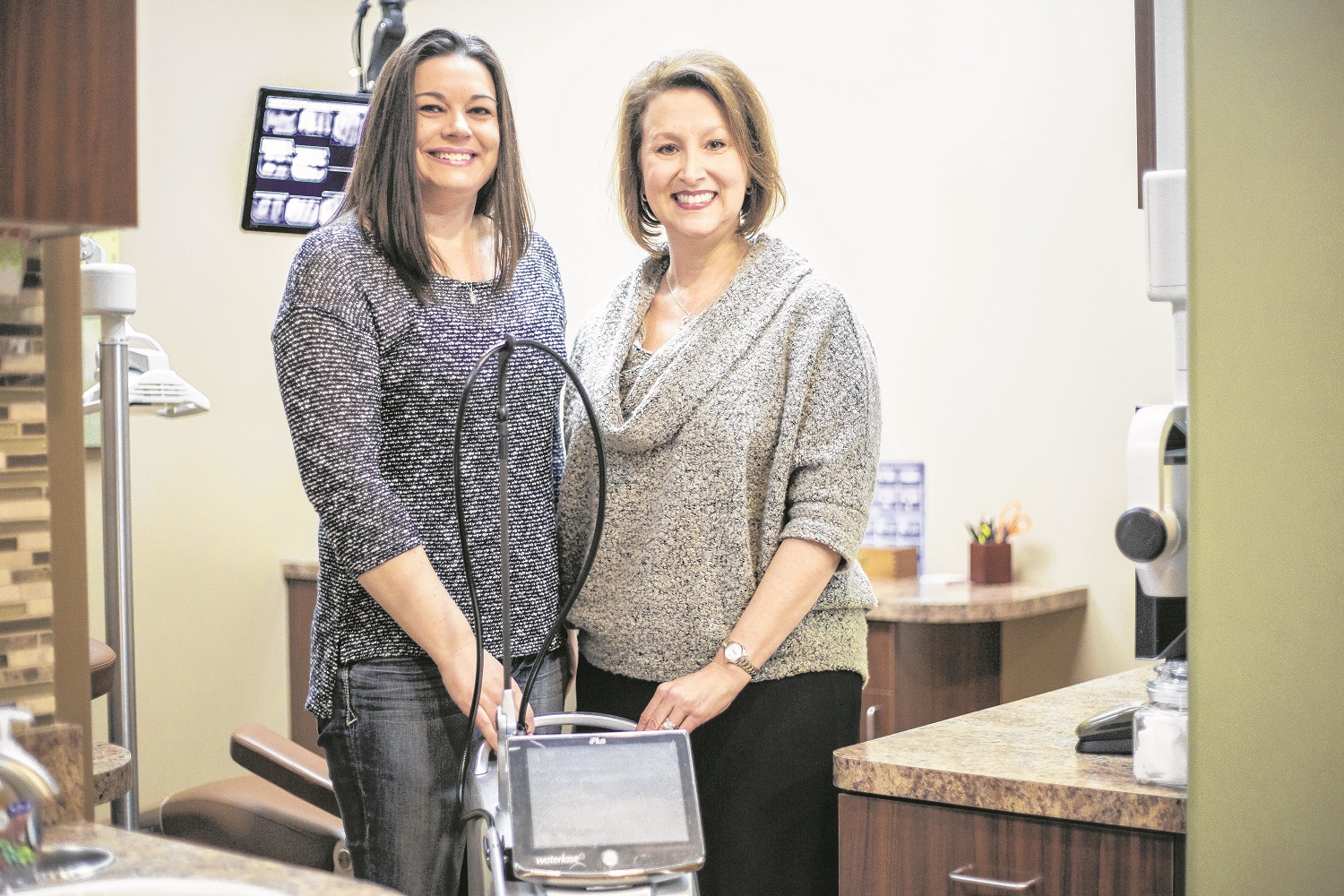
By M.V. Moorhead
If Roxanne Huber or Stacy Tracy had been my childhood dentist, I might have a healthier mouth today.
Well, I guess that wouldn’t work, considering that both of the partners in Tempe Smile Design are younger than I am. So OK, if a dentist like Huber or Tracy had been my childhood dentist, I might have a healthier mouth today.
But then, back in the ‘60s and ‘70s, you generally couldn’t watch your favorite show or listen to some good music, while your dentist worked on you.
In the tranquil offices of Tempe Smile Design, big-screen TVs look down on the chairs in the treatment rooms, so you can watch Netflix, or your kids can watch Spongebob, while you (or they) get a filling or routine cleaning.
If even that isn’t enough to help, says Huber, the office offers“nitrous gas for nervous children, and neck pillows and blankets in every room.”
“Dr. Huber and I are very good, especially with children, about telling them what’s going to happen,” says Tracy.
Still, she says, “I sneak the injections in. We really care that they don’t hurt.”
Besides, adds Huber, “The equipment has improved greatly. It’s faster, it’s smoother, and the delivery of the water is much better, which keeps the tooth cooler.”
Even the surroundings aren’t as intimidating. Instead of the old-school clinical white walls, the partners worked with a designer to create a welcoming atmosphere with a soothing color scheme of olive green and beige and brown.
The two met through a practice management service that they describe as “like match.com or eharmony for dentists…We had to take personality tests on things like practice philosophy and conflict resolution.”
Apparently these tests worked—they’ve been in practice together for 10 years this summer.
Huber, a Bismarck, North Dakota native, attended the University of Minnesota, knowing she wanted to work in a medical field and eventually settling on dentistry. A native of San Antonio, Texas, Tracy has a more vivid story of what inspired her career choice—it all started on the monkey bars, when she was in third grade…
“I could do a trick where I’d leap from the ladder and grab the third rung. One time my friend dared me to try for the fourth rung.” The result, says Tracy, “was very gory.”
Multiple dental surgeries ensued, during which, she recalls, “I used to watch the endodontist working with his glasses, and it just fascinated me.”
Long before she got to the University of Texas-San Antonio, she already knew what she wanted for a career.
In my own case as a boy growing up in small-town Pennsylvania, my formative dental experiences were different. The dentist I went to as a kid was a warm, funny, delightful man. I have very fond memories of him personally, but I loathed going to dental appointments. Mostly, no doubt, this was because I was a little coward who recoiled at the idea of the slightest discomfort (some things never change).
But it was also because this guy, who had been a U.S. Navy dentist, eschewed the use of anesthetics. I always had the impression he somehow disapproved of them, almost on principle. I recall him finally adopting Novocain—in what felt to me like the lowest possible doses—at some point, but it seemed like he did so grudgingly.
As a result, I’ve been phobic about dentistry ever since childhood, and have avoided going to the dentist as an adult as much as I thought I could get away with. This is a particular misfortune for me, since genetics has also blessed me with a pretty high-maintenance set of choppers.
It’s possible that many people of my generation share my fear, and not only can it lead them to neglect their own dental health, it could also be a bad habit they pass on to their own kids.
But, says Tracy, “It’s great for parents to go regularly too, to set a good example for children.”
Although Tracy and Huber’s practice is general rather than pediatric dentistry, they note that the American Dental Association recommends that children start seeing a dentist at one year of age.
“We’re seeing them early on,” says Tracy, “and it’s not scary; we’re looking, we’re talking. There’s no work yet.”
“Those first few visits,” says Huber, “are as much for the parents as for the children. It’s teaching them about sugars and pacifiers and thumb sucking and all of the things that can affect their teeth.”
Baby teeth are more important than is sometimes realized, according to the doctors. They hold space for adult teeth, and abscesses on them can harm adult teeth behind them. Besides, they add, cavities on baby teeth can be very painful.
Another development in modern dentistry, say Huber and Tracy, is the focus on preventative care, like fluoride, sealants and the early diagnosis of cavities.
“It’s different from past generations, when they only went to the dentist when teeth hurt or broke.”
And it isn’t just younger kids who need to keep up with their dental care, Huber and Tracy stress. “It’s important to see a dentist before going off to college. We see a lot of teens who came from other cities or states that either had never been to a dentist or hadn’t been in years, and they have a mouth full of cavities or wisdom teeth.
All of these issues tend to become a problem when they’re away….with parents long distance and reviewing the treatment plan and payment over the phone or emails.”
Despite all of these issues, spread across all of these age groups, Huber and Tracy take pride in making Tempe Smile Design a comfortable, relaxing place to go. Indeed, notes Huber, “people fall asleep in the chair. In fact, she notes, “People fall asleep several times a week.”
Information: 480-829-8200. Website: stacytracydds.com

